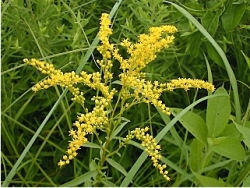 Species
Species
Click here for a cross-reference alphabetical listing of the
plants' common names.
- Acorus calamus
- Alisma subcordatum
- Amorpha canescens
- Amorpha fruticosa
- Anemone canadensis
- Angelica atropurpurea
- Aquilegia canadensis
- Asclepias incarnata
- Asclepias tuberosa
- Aster (Symphyotrichum) azureus
- Aster (Symphyotrichum) novae-angliae
- Baptisia leucantha
- Baptisia leucophaea
- Boltonia asteroides var. latisquama
- Bulboschoenus fluviatilis
- Calamagrostis canadensis
- Caltha palustris
- Carex aquatilis
- Carex bicknellii
- Carex comosa
- Carex cristatella
- Carex hystericina
- Carex lacustris
- Carex lupulina
- Carex molesta
- Carex pellita
- Carex stricta
- Carex tribuloides
- Carex trichocarpa
- Carex vulpinoidea
- Cephalanthus occidentalis
- Coreopsis palmata
- Cornus obliqua
- Cornus stolonifera
- Decodon verticillatus
- Dodecatheon meadia
- Echinacea pallida
- Eleocharis acicularis
- Eryngium yuccafolium
- Eupatorium maculatum
- Eupatorium perfoliatum
- Filipendula rubra
- Gentiana andrewsii
- Geranium maculatum
- Geum triflorum
- Helenium autumnale
- Heuchera richardsonii
- Hibiscus palustris
- Hypericum pyramidatum
- Illiamna remota
- Iris virginica var. shrevei
- Juncus dudleyi
- Juncus effusus
- Juncus torreyi
- Justicia americana
- Lespedeza capitata
- Liatris pychnostachya
- Liatris spicata
- Lobelia cardinalis
- Lobelia siphilitica
- Lythrum alatum
- Mimulus ringens
- Nuphar variegata
- Nymphaea odorata
- Panicum virgatum
- Parthenium integrifolium
- Peltandra virginica
- Penstemon digitalis
- Petalostemum purpureum (Dalea gattingeri)
- Phlox pilosa var. fulgida
- Physostegia virginiana var. speciosa
- Polygonum amphibium
- Pontedaria cordata
- Pycanthemum virginianum
- Ratibida pinnata
- Rudbeckia subtomentosa
- Rumex verticillatus
- Sagittaria latifolia
- Salix discolor
- Saururus cernuus
- Sambucus canadensis
- Schizachyrium scoparium
- Schoenoplectus acutus
- Schoenoplectus pungens
- Schoenoplectus tabernaemontani
- Scirpus atrovirens
- Scirpus cyperinus
- Scirpus pendulus
- Silphium integrifolium
- Silphium laciniatum
- Silphium perfoliatum
- Silphium terebinthinaceum
- Solidago graminifolia
- Solidago juncea
- Solidago speciosa
- Sparganium eurycarpum
- Spartina pectinata
- Spiraea alba
- Sporobolus heterolepis
- Thalictrum dasycarpum
- Tradescantia ohiensis
- Verbena hastata
- Vernonia fasciculata
- Veronicastrum virginicum
- Zizia aurea

